英语病历
医学英语病历范文
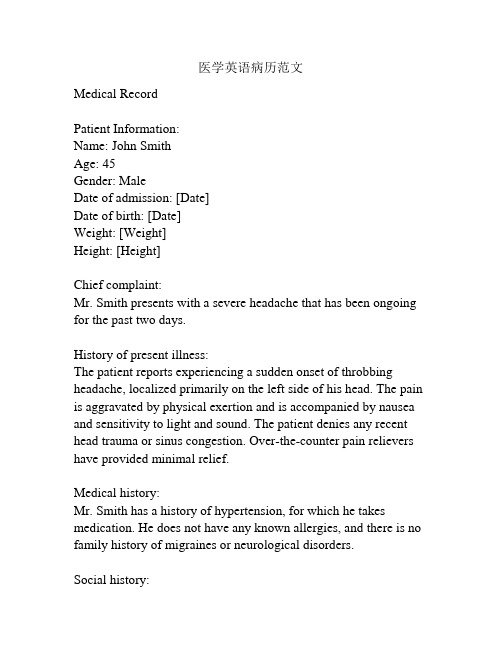
医学英语病历范文Medical RecordPatient Information:Name: John SmithAge: 45Gender: MaleDate of admission: [Date]Date of birth: [Date]Weight: [Weight]Height: [Height]Chief complaint:Mr. Smith presents with a severe headache that has been ongoing for the past two days.History of present illness:The patient reports experiencing a sudden onset of throbbing headache, localized primarily on the left side of his head. The pain is aggravated by physical exertion and is accompanied by nausea and sensitivity to light and sound. The patient denies any recent head trauma or sinus congestion. Over-the-counter pain relievers have provided minimal relief.Medical history:Mr. Smith has a history of hypertension, for which he takes medication. He does not have any known allergies, and there is no family history of migraines or neurological disorders.Social history:The patient is a smoker, consuming approximately 10 cigarettes per day. He drinks alcohol in moderation, primarily on social occasions. He denies any illicit drug use. His occupation involves long hours of computer work.Physical examination:On examination, the patient appears to be in mild distress due to the headache. His vital signs are within normal limits. Neurological examination reveals no focal deficits, and his cranial nerves appear to be intact. There is no evidence of meningeal irritation. His neck is supple, and there is no nuchal rigidity. The remainder of the physical examination is unremarkable. Laboratory tests:Blood tests, including a complete blood count and comprehensive metabolic panel, were performed. All results were within normal limits.Imaging studies:A brain MRI was ordered to rule out any structural abnormalities. The scan revealed no evidence of intracranial hemorrhage, mass, or other abnormalities.Assessment and plan:Mr. Smith is presenting with a severe headache consistent with a migraine without aura. He will be prescribed a triptan medication for acute management of his headache. He will also be counseled on lifestyle modifications, including smoking cessation and stress reduction techniques. A follow-up appointment will be scheduled in two weeks to evaluate the effectiveness of the treatment plan.Additionally, the patient is advised to seek immediate medical attention if his symptoms worsen or if he develops any new neurological symptoms.Signature: [Physician's Name]Date: [Date]。
英语病历报告作文格式
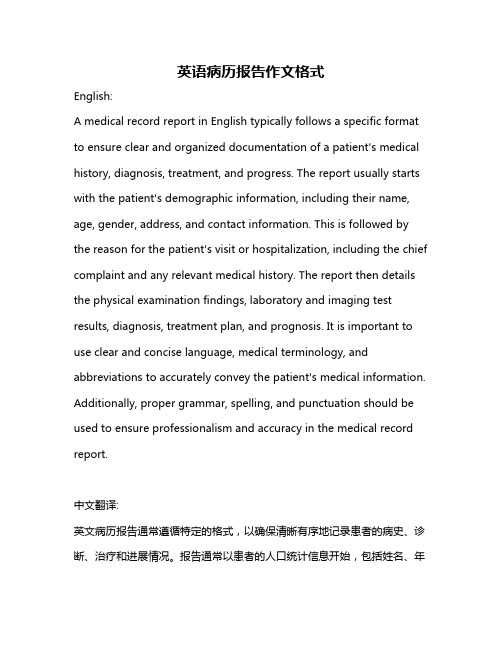
英语病历报告作文格式English:A medical record report in English typically follows a specific format to ensure clear and organized documentation of a patient's medical history, diagnosis, treatment, and progress. The report usually starts with the patient's demographic information, including their name, age, gender, address, and contact information. This is followed by the reason for the patient's visit or hospitalization, including the chief complaint and any relevant medical history. The report then details the physical examination findings, laboratory and imaging test results, diagnosis, treatment plan, and prognosis. It is important to use clear and concise language, medical terminology, and abbreviations to accurately convey the patient's medical information. Additionally, proper grammar, spelling, and punctuation should be used to ensure professionalism and accuracy in the medical record report.中文翻译:英文病历报告通常遵循特定的格式,以确保清晰有序地记录患者的病史、诊断、治疗和进展情况。
英语病历作文格式模板
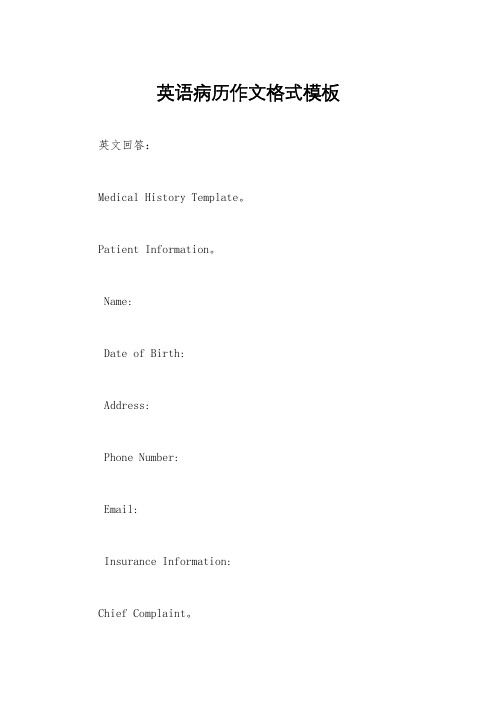
英语病历作文格式模板英文回答:Medical History Template。
Patient Information。
Name:Date of Birth:Address:Phone Number:Email:Insurance Information:Chief Complaint。
A brief summary of the patient's primary reason for the visit.Example: "The patient presents with a 3-day history of fever and chills."History of Present Illness。
A detailed description of the patient's symptoms, including:Onset: When did the symptoms first appear?Duration: How long have the symptoms been present?Severity: How severe are the symptoms?Location: Where are the symptoms located?Associated symptoms: Any other symptoms that are present, such as nausea, vomiting, or headache.Past Medical History。
A list of any previous medical conditions, surgeries, or hospitalizations.Example: "The patient has a history of hypertension and hyperlipidemia."Family History。
英语病历卡作文

英语病历卡作文Patient Name: Jane SmithAge: 45 years oldGender: FemaleOccupation: TeacherDate of Admission: August 15th, 2021Chief Complaint:Patient presents with a two-week history of persistent cough, shortness of breath, and fatigue.History of Present Illness:The patient reports that she first noticed the symptoms two weeks ago. The cough is dry and has been keeping her up at night. She also feels short of breath with minimal exertion and has been feeling extremely tired and weak.Past Medical History:The patient has a history of asthma, which is well-controlled with an inhaler. She also has a history of seasonal allergies.Medications:- Albuterol inhaler for asthma- Loratadine for allergiesAllergies:The patient is allergic to penicillin.Family History:There is a family history of asthma on the patient's mother's side.Social History:The patient is a non-smoker and does not drink alcohol. She works as a teacher and lives with her husband and two children.Review of Systems:- General: Fatigue- Respiratory: Cough, shortness of breath- Cardiovascular: No chest pain or palpitations- Gastrointestinal: No nausea, vomiting, or diarrhea - Neurological: No headaches or dizzinessPhysical Examination:- Vital Signs:- Blood Pressure: 120/80 mmHg- Heart Rate: 80 bpm- Respiratory Rate: 20 breaths per minute- Temperature: 98.6°F- General: Patient appears fatigued- Respiratory: Decreased breath sounds and wheezing heard on auscultation- Cardiovascular: Regular rate and rhythm, no murmurs - Gastrointestinal: Soft and non-tender abdomenDiagnostic Tests:- Chest X-ray: Atelectasis in the left lower lobe- Pulmonary Function Tests: Decreased FEV1/FVC ratio consistent with obstructive lung diseaseAssessment:- Acute exacerbation of asthma with atelectasis in the left lower lobePlan:- Start oral prednisone for asthma exacerbation- Continue albuterol inhaler every 4-6 hours as needed - Incentive spirometry to improve lung function- Follow-up in 1 week for re-evaluation中文病历卡作文:患者姓名:简·史密斯年龄:45岁性别:女职业:教师入院日期:2021年8月15日主诉:患者自述持续咳嗽、气促和疲劳已有两周之久。
英语简要病历报告作文

英语简要病历报告作文Title: Patient Medical Report: A Case of Respiratory Infection。
Date: April 16, 2024。
Patient Information:Name: [Patient Name]Age: [Age]Gender: [Gender]Date of Admission: [Date]Admitting Physician: Dr. [Physician Name]Chief Complaint:The patient presents with symptoms of cough, fever, shortness of breath, and fatigue.History of Present Illness:The patient, [Patient Name], a [Age]-year-old [Gender], presented to the emergency department with complaints of cough, fever, shortness of breath, and fatigue for the past five days. The cough was productive, with yellowish-green sputum. The fever was intermittent and associated with chills. The patient also reported experiencing mild chest pain exacerbated by coughing.Past Medical History:The patient has a past medical history significant for asthma, for which they use an inhaler as needed. There are no known allergies to medications.Medications:The patient takes [Medication Name] for asthma asneeded.Social History:The patient is a non-smoker and denies any history of alcohol or illicit drug use. They work as a [Occupation] and have no recent travel history.Family History:There is no significant family history of respiratory illnesses.Physical Examination:On physical examination, the patient was febrile with a temperature of [Temperature], tachycardic with a heart rate of [Heart Rate], and tachypneic with a respiratory rate of [Respiratory Rate]. Oxygen saturation was [Oxygen Saturation]% on room air. Lung auscultation revealed coarse crackles in the lower lung fields bilaterally. There was no evidence of cyanosis, clubbing, or peripheral edema. 。
医学英语病历书写重点
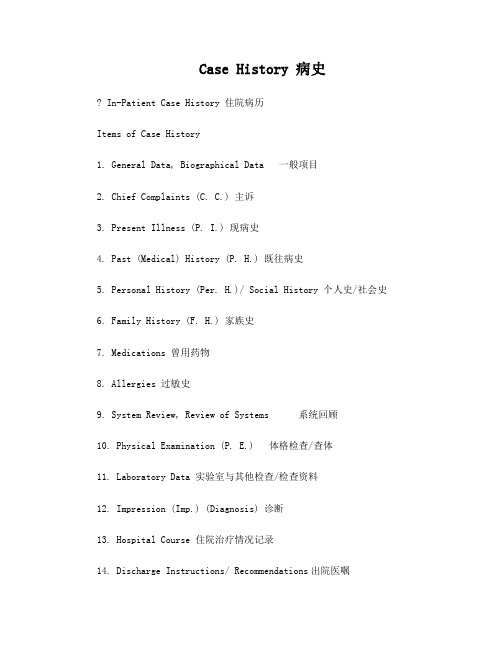
Case History 病史In-Patient Case History 住院病历Items of Case History1. General Data, Biographical Data 一般项目2. Chief Complaints (C. C.) 主诉3. Present Illness (P. I.) 现病史4. Past (Medical) History (P. H.) 既往病史5. Personal History (Per. H.)/ Social History 个人史/社会史6. Family History (F. H.) 家族史7. Medications 曾用药物8. Allergies 过敏史9. System Review, Review of Systems 系统回顾10. Physical Examination (P. E.) 体格检查/查体11. Laboratory Data 实验室与其他检查/检查资料12. Impression (Imp.) (Diagnosis) 诊断13. Hospital Course 住院治疗情况记录14. Discharge Instructions/ Recommendations出院医嘱15. Discharge Medications 出院后用药General Data, Biographical Data 一般项目Reliability (病历可靠性):Reliable(可靠)/ Not Entirely(不完全可靠)/Not Clearly Defined (不够准确)/Confused and Uncertain (混乱不清)/ Unobtainable (无法获得)Supplier/ Complainer of History (供史者/病史陈述者):Patient/ Husband/ Wife/ Father/ Mother/ Colleague/ NeighborChief Complaints (C. C.) 主诉: 病例重要部分之一,通常包括患者年龄、简要的相关的既往史、患者的就诊原因及目前症状持续的时间等。
医学英语病历书写范文
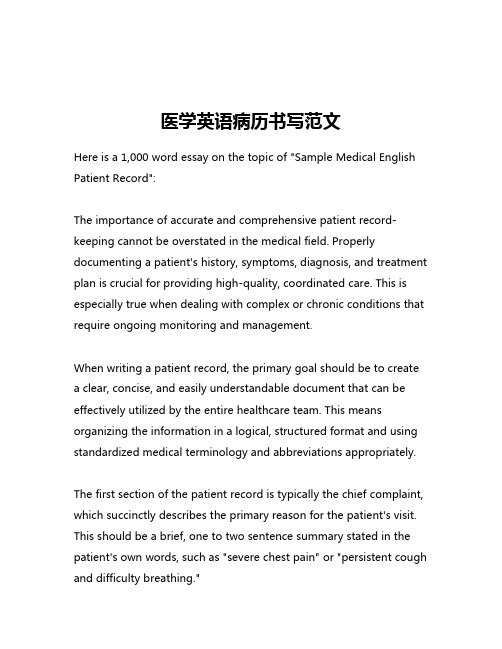
医学英语病历书写范文Here is a 1,000 word essay on the topic of "Sample Medical English Patient Record":The importance of accurate and comprehensive patient record-keeping cannot be overstated in the medical field. Properly documenting a patient's history, symptoms, diagnosis, and treatment plan is crucial for providing high-quality, coordinated care. This is especially true when dealing with complex or chronic conditions that require ongoing monitoring and management.When writing a patient record, the primary goal should be to create a clear, concise, and easily understandable document that can be effectively utilized by the entire healthcare team. This means organizing the information in a logical, structured format and using standardized medical terminology and abbreviations appropriately.The first section of the patient record is typically the chief complaint, which succinctly describes the primary reason for the patient's visit. This should be a brief, one to two sentence summary stated in the patient's own words, such as "severe chest pain" or "persistent cough and difficulty breathing."Next, the history of present illness (HPI) provides more detailed information about the current health issue. This section should cover the timeline of symptom onset and progression, any aggravating or alleviating factors, associated signs and symptoms, and previous treatments tried. The HPI allows the clinician to develop a comprehensive understanding of the patient's condition.The past medical history section documents the patient's broader health background, including any chronic diseases, prior hospitalizations or surgeries, and relevant family health history. Capturing this contextual information is vital, as it can greatly inform the diagnostic process and guide appropriate management.The review of systems (ROS) involves systematically inquiring about and documenting pertinent positive and negative findings across all major body systems. This thorough assessment helps identify any additional medical issues that may be relevant, even if not directly related to the chief complaint.The physical examination portion of the record details the clinician's observations and measurements from the hands-on assessment. This can include vital signs, general appearance, specific findings from each body system examination, and any diagnostic test results. Clear, objective language should be used to describe the relevant physicalexam elements.Based on the information gathered in the previous sections, the assessment and plan section provides the clinician's medical decision-making. This includes the patient's working diagnosis or problem list, the rationale supporting this conclusion, and the proposed treatment strategy. The plan may involve medication prescriptions, referrals to specialists, recommended lifestyle modifications, and plans for ongoing monitoring and follow-up.Throughout the patient record, it is critical to use standardized medical terminology and abbreviations correctly. This ensures accurate communication and reduces the risk of ambiguity or misinterpretation. Additionally, all entries should be dated, timed, and signed by the responsible clinician.Proper documentation not only supports effective patient care, but also has important legal and financial implications. Patient records may be used as evidence in malpractice cases, to justify insurance claims, or to demonstrate compliance with regulatory requirements. Clinicians must be diligent in creating thorough, high-quality records that fully capture the patient encounter.Beyond these general principles, the specific formatting and required elements of a patient record can vary somewhat based on thehealthcare setting, clinical specialty, and organizational policies. For example, emergency department visit notes may have a different structure than those for outpatient primary care appointments.Regardless of the particular template used, the overarching goals remain the same - to document the patient's story in a clear, comprehensive, and legally-defensible manner. By mastering the art of effective medical record-keeping, clinicians can strengthen interprofessional communication, enhance continuity of care, and ultimately improve patient outcomes.。
英语大病历模板
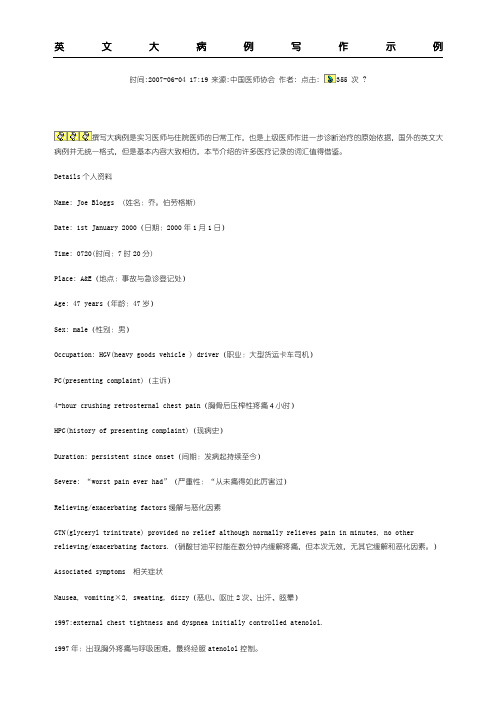
英文大病例写作示例时间:2007-06-04 17:19来源:中国医师协会作者: 点击: 355 次 ?撰写大病例是实习医师与住院医师的日常工作,也是上级医师作进一步诊断治疗的原始依据,国外的英文大病例并无统一格式,但是基本内容大致相仿,本节介绍的许多医疗记录的词汇值得借鉴。
Details个人资料Name: Joe Bloggs(姓名:乔。
伯劳格斯)Date: 1st January 2000(日期:2000年1月1日)Time: 0720(时间:7时20分)Place: A&E(地点:事故与急诊登记处)Age: 47 years(年龄:47岁)Sex: male(性别:男)Occupation: HGV(heavy goods vehicle ) driver(职业:大型货运卡车司机)PC(presenting complaint)(主诉)4-hour crushing retrosternal chest pain(胸骨后压榨性疼痛4小时)HPC(history of presenting complaint)(现病史)Duration: persistent since onset(间期:发病起持续至今)Severe: “worst pain ever had”(严重性:“从未痛得如此厉害过)Relieving/exacerbating factors缓解与恶化因素GTN(glyceryl trinitrate) provided no relief although normally relieves pain in minutes, no other relieving/exacerbating factors.(硝酸甘油平时能在数分钟内缓解疼痛,但本次无效,无其它缓解和恶化因素。
)Associated symptoms相关症状Nausea, vomiting×2, sweating, dizzy(恶心、呕吐2次、出汗、眩晕)1997:external chest tightness and dyspnea initially controlled atenolol.1997年:出现胸外疼痛与呼吸困难,最终经服atenolol控制。
英语病历范文
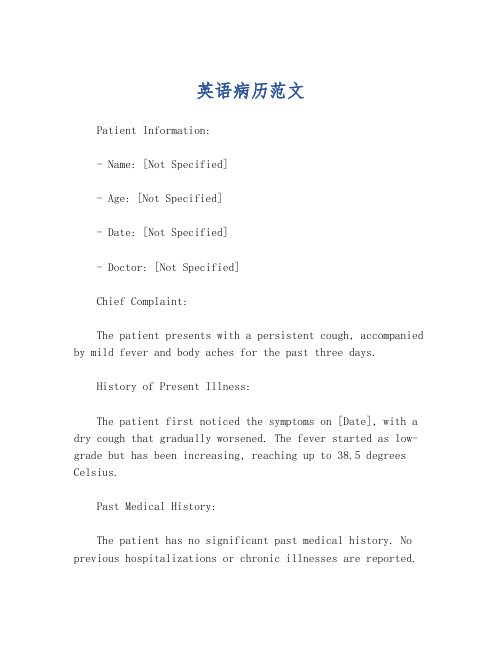
英语病历范文Patient Information:- Name: [Not Specified]- Age: [Not Specified]- Date: [Not Specified]- Doctor: [Not Specified]Chief Complaint:The patient presents with a persistent cough, accompanied by mild fever and body aches for the past three days.History of Present Illness:The patient first noticed the symptoms on [Date], with a dry cough that gradually worsened. The fever started as low-grade but has been increasing, reaching up to 38.5 degrees Celsius.Past Medical History:The patient has no significant past medical history. No previous hospitalizations or chronic illnesses are reported.Medications:The patient has not taken any medications for the current illness, nor are they on any regular medication.Allergies:No known allergies to medications or environmental factors.Physical Examination:Vital signs: Temperature 38.3°C, Puls e 92 bpm, Respiratory rate 20 breaths per minute, Blood pressure 120/80 mmHg. The patient appears fatigued but in no acute distress. Lungs are clear to auscultation with no wheezing or crackles. The throat is slightly red without exudates.Assessment:Based on the symptoms and physical examination, the patient is likely suffering from a viral upper respiratory infection.Plan:1. Hydration and rest are recommended.2. Over-the-counter fever reducers and cough suppressants may be used as needed for symptomatic relief.3. If symptoms persist or worsen, the patient should return for further evaluation and potential testing for influenza or COVID-19.Follow-up:The patient is advised to follow up in one week if symptoms have not improved or if new symptoms develop.Instructions:- Increase fluid intake to prevent dehydration.- Avoid contact with others to prevent the spread of the infection.- Monitor for signs of worsening condition, such as difficulty breathing, persistent high fever, or chest pain.Note: This is a hypothetical patient case and should not be used as a substitute for professional medical advice, diagnosis, or treatment.。
英语病历模板范文

英语病历模板范文Patient Identification:Date of Birth: [DOB]Sex: [Male/Female]Patient ID: [Unique Identifier]Chief Complaint:[Patient's primary concern or reason for the visit, e.g., "Severe headache for the past 3 days"]History of Present Illness:[Detailed account of the onset, duration, severity, and any associated symptoms of the current illness. Include any treatments already attempted.]Past Medical History:[List any previous medical conditions, surgeries, or hospitalizations.]Medications:[List all current medications, including dosages andfrequency.]Allergies:[Note any known allergies to medications, foods, or environmental factors.]Family Medical History:[Provide information on any significant medicalconditions in the patient's family.]Social History:[Include relevant lifestyle factors such as smoking status, alcohol consumption, exercise habits, and occupation.]Review of Systems:[Briefly summarize the patient's current state inrelation to various body systems, e.g., "No chest pain, no shortness of breath."]Physical Examination:[Record findings from the physical examination, including vital signs, general appearance, and specific observations related to the chief complaint.]Assessment:[Summarize the likely diagnosis or condition based on the information gathered.]Plan:[Outline the proposed treatment plan, including medications, referrals, follow-up appointments, and any necessary tests or procedures.]。
Admission Notes英文版病例 英语病历
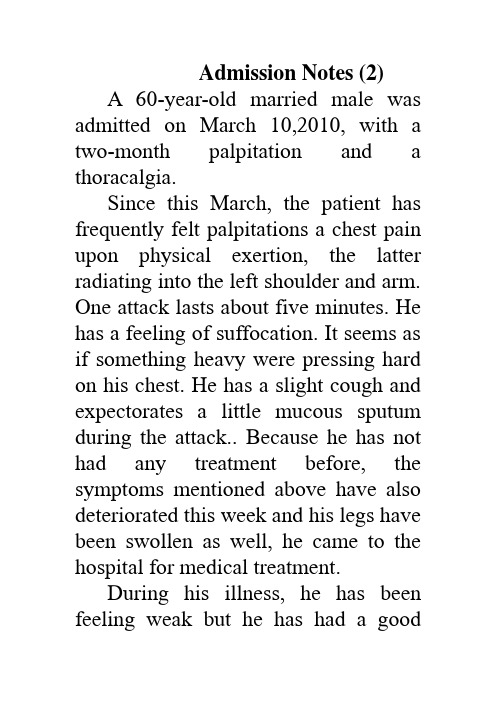
Admission Notes (2)A 60-year-old married male was admitted on March 10,2010, with a two-month palpitation and a thoracalgia.Since this March, the patient has frequently felt palpitations a chest pain upon physical exertion, the latter radiating into the left shoulder and arm. One attack lasts about five minutes. He has a feeling of suffocation. It seems as if something heavy were pressing hard on his chest. He has a slight cough and expectorates a little mucous sputum during the attack.. Because he has not had any treatment before, the symptoms mentioned above have also deteriorated this week and his legs have been swollen as well, he came to the hospital for medical treatment.During his illness, he has been feeling weak but he has had a goodappetite, and his bowel motions and micturition have remained normal.He said that he had been perfectly healthy and had never had rheumatic fever or heart trouble previously.There is nothing particular in his family medical history.PE T: 36.7”C; P:100/min. R:20/min.;BP:140/80mmHg(19—11kPa).Well developed and nourished. In his right mind and in voluntary position. No dyspnea or cyanosis detected. No eruption or purpura over skin. Superficial lymph nodes impalpable. Skull and head organs not abnormal. Neck soft and supple and free of venous engorgement. Trachea in midline. Thyroid not enlarged. Chest symmetrical. Lungs clear. Heart enlarged and leftward without irregular beats. Heart rate 100/min. A grade—IIIharsh blowing systolic murmur heard at the apical area with no thrill felt or diastolic murmur heard. Abdomen flat with no tenderness. Liver felt 2 fb below costal margin. Hepatojugular reflux negative. Spleen not palpable. No shifting dullness over abdomen heard. Slight edema in both ankles present. Bilateral knee jerk reflexes active. No pathological neural reflex found.Chest fluoroscopy reveals general cardiac enlargement.ECG shows:1.sinus rhythm2.left ventricular hypertrophy3.chronic coronary insufficiency Diagnosis: Coronary Heart Disease Left V entricular HypertrophyAngina Pectoris Signature: Date:。
医学英语病历写作范文
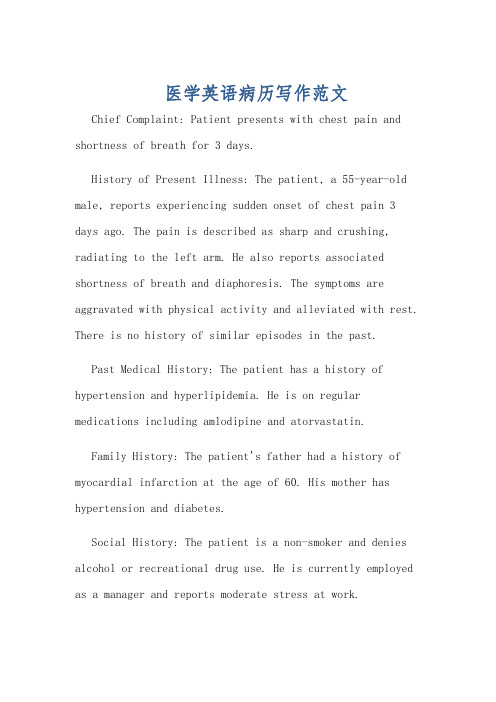
医学英语病历写作范文Chief Complaint: Patient presents with chest pain and shortness of breath for 3 days.History of Present Illness: The patient, a 55-year-old male, reports experiencing sudden onset of chest pain 3 days ago. The pain is described as sharp and crushing, radiating to the left arm. He also reports associated shortness of breath and diaphoresis. The symptoms are aggravated with physical activity and alleviated with rest. There is no history of similar episodes in the past.Past Medical History: The patient has a history of hypertension and hyperlipidemia. He is on regular medications including amlodipine and atorvastatin.Family History: The patient's father had a history of myocardial infarction at the age of 60. His mother has hypertension and diabetes.Social History: The patient is a non-smoker and denies alcohol or recreational drug use. He is currently employed as a manager and reports moderate stress at work.Review of Systems: The patient denies any recent weight changes, fever, or chills. There is no history of cough, sputum production, or hemoptysis. He denies any gastrointestinal symptoms such as nausea, vomiting, or abdominal pain.Physical Examination:- Vital signs: Blood pressure 140/90 mmHg, heart rate 90 bpm, respiratory rate 20 breaths per minute, oxygen saturation 96% on room air.- General: The patient appears uncomfortable and diaphoretic.- Cardiovascular: Regular rhythm, no murmurs, rubs, or gallops. Capillary refill time is less than 2 seconds.- Respiratory: Clear breath sounds bilaterally, no wheezing or crackles.Assessment and Plan:1. Rule out acute coronary syndrome: The patient's presentation is concerning for acute coronary syndrome given the symptoms of chest pain, shortness of breath, anddiaphoresis. ECG and cardiac enzymes will be obtained to evaluate for myocardial ischemia.2. Blood pressure management: The patient's blood pressure is elevated, and optimization of antihypertensive medications will be addressed.3. Lipid management: Given the patient's history of hyperlipidemia, lipid panel will be obtained to assess for dyslipidemia and adjust medications as needed.4. Stress management: The patient's moderate stress at work will be addressed through counseling and potential referral to a stress management program.中文病历:主诉:患者因胸痛和呼吸急促已3天。
[终稿]医学英语病历
![[终稿]医学英语病历](https://img.taocdn.com/s3/m/a3e23db6b1717fd5360cba1aa8114431b90d8e65.png)
医学英语病历医学英语病历1.抗生素医嘱[Antibiotic order]·Prophylaxis [预防性用药] Duration of oder[用药时间] 24hr Procedure[操作,手术]·Empiric theraphy [经验性治疗]Suspected site and organism[怀疑感染的部位和致病菌] 72hr Cultures ordered[是否做培养]·Documented infection[明确感染]Site and organism[部位和致病菌] 5days·Other[其他]Explanation required [解释理由] 24hr·Antibiotic allergies[何种抗生素过敏]No known allergy [无已知的过敏]·Drug+dose+Route+frequency[药名+剂量+途径+次数]2、医嘱首页[Admission / transfer]·Admit / transfer to [收入或转入]·Resident [住院医师] Attending[主治医师]·Condition [病情]·Diagnosis[诊断]·Diet [饮食]·Acitivity [活动]·Vital signs[测生命体征]·I / O [记进出量]·Allergies[过敏]3、住院病历[case history]·Identification [病人一般情况]Name[性名]Sex[性别]Age [年龄]Marriage[婚姻]Person to notify and phone No.[联系人及电话] Race[民族]I.D.No.[身份证]Admission date[入院日期]Source of history[病史提供者]Reliability of history[可靠程度]Medical record No[病历号]Business phone No.[工作单位电话]Home address and phone No.[家庭住地及电话] ·Chief complaint[主诉]·History of present illness[现病史]·Past History[过去史]Surgical[外科]Medical[内科]Medications[用药]Allergies[过敏史]Social History[社会史]Habits[个人习惯]Smoking[吸烟]Family History[家族史]Ob/Gyn History[ 婚姻/生育史]Alcohol use[喝酒]·Review of Aystems[系统回顾]General[概况]Eyes,Ears,Nose and throat[五官] Pulmonary[呼吸]Cardiovascular[心血管]GI[消化]GU[生殖、泌尿系统]Musculoskeletal[肌肉骨骼]Neurology[神经系统]Endocrinology[内分泌系统]Lymphatic/Hematologic[淋巴系统/血液系统]·Physical Exam[体检]Vital Signs[生命体征]P[脉博]Bp[血压]R[呼吸]T[温度]Height[身高]Weight[体重]General[概况]HEENT[五官]Neck[颈部]Back/Chest[背部/胸部]Breast[乳房]Heart[心脏]Heart rate[心率]Heart rhythm[心律]Heart Border[心界]Murmur[杂音]Abdomen[腹部]Liver[肝]Spleen[脾]Rectal[直肠]Genitalia[生殖系统]Extremities[四肢]Neurology[神经系统]cranial nerves[颅神经]sensation[感觉]Motor[运动]*Special P.E. on diseased organ system[专科情况] *Radiographic Findings[放射]*Laboratory Findings[化验]*Assessment[初步诊断与诊断依据]*Summary[病史小结]*Treatment Plan[治疗计划]4、输血申请单[Blood bank requisition form](1)reason for infusion[输血原因]▲红细胞[packed red cells, wshed RBCs]:*Hb<8.5 [血色素<8.5]*>20% blood volume lost [>20%血容量丢失]*cardio-pulmonary bypass with anticipated Hb <8[心肺分流术伴预计血色素<8]*chemotherapy or surgery with Hb <10[血色素<10的化疗或手术者]▲全血[whole blood]:massive on-going blood loss[大量出血]▲血小板[platelets]:*massive blood transfusion >10 units[输血10单位以上者]*platelet count <50×103/μl with active bleeding or surgery[血小板<5万伴活动性出血或手术者]*Cardio-pulmonary bypass uith pl<100×103/μl with octive bleeding[心肺分流术伴血小板<10万,活动性出血者]*Platelet count <20×103/μl[血板<2万]▲新鲜冰冻血浆[fresh frozen plasma]:*documented abnormal PT or PTT with bleeding or Surgery[PT、PTT异常的出血或手术病人]*specific clotting factor deficiencies withbleeding/surgerg[特殊凝血因子缺乏的出血/手术者]*blood transfusion >15units[输血>15个单位]*warfarin or antifibrinolytic therapy with bleeding[华法令或溶栓治疗后出血]*DIC[血管内弥漫性凝血]*Antithrombin III dficiency[凝血酶III 缺乏](2)输血要求[request for blood components]*patient blood group[血型]*Has the patient had transfusion or pregnancy in the past 3 months? [近3个月,病人是否输过血或怀孕过?]*Type and crossmatch[血型和血交叉]*Units or ml[单位或毫升]5、出院小结[discharge summary]Patient Name[病人姓名]Medical Record No.[病历号]Attending Physician[主治医生]Date of Admission[入院日期]Date of Discharge[出院日期]Pirncipal Diagnosis[主要诊断]Secondary Diagnosis[次要诊断]Complications[并发症]Operation[手术名称]Reason for Admission[入院理由]Physical Findings[阳性体征]Lab/X-ray Findings[化验及放射报告]Hospital Course[住院诊治经过]Condition[出院状况]Disposition[出院去向]Medications[出院用药]Prognosis[预后]Special Instruction to the Patient(diet, physical activity)[出院指导(饮食,活动量)]Follow-up Care[随随访]6、住院/出院病历首页[Admission/discharge record]·Patient name[病人姓名]·race[种族]·address[地址]·religion[宗教]·medical service[科别]·admit (discharge) date[入院(出院)日期]·Length of stay [住院天数]·guarantor na me [担保人姓名]·next of kin or person to notify[需通知的亲属姓名] ·relation to patient[与病人关系]·previous admit date[上次住院日期]·admitting physician [入院医生]·attending phgsician[主治医生]·admitting diagnosis[入院诊断]·final (principal) diagnosis[最终(主要)诊断] ·secondary diagnosis[次要诊断]·adver se reactions (complications)[副作用(合并症)] ·incision type[切口类型]·healing course[愈合等级]·operative (non-operative) procedures[手术(非手术)操作] ·nosocomial infection[院内感染]·consutants[会诊]·Critical-No. of times[抢救次数]·recovered-No. of times[成功次数]·Diagnosis qualitative analysi s[诊断质量]OP.adm.and discharge Dx concur [门诊入院与出院诊断符合率]Clinical and pathological Dx concur[临床与病理诊断符合率] Pre- and post-operative Dx concur [术前术后诊断符合率]·Dx determined with in 24 hours (3 days) after admission[入院后24小时(3天)内确诊]·Discharge status[出院状况]recovered[治愈]improved[好转]not improved[未愈]died [死亡]·Dispositon[去向]home[家]against medical ad[自动出院]autosy[尸检]transferred to[转院到]。
医学英语口语:英文病历
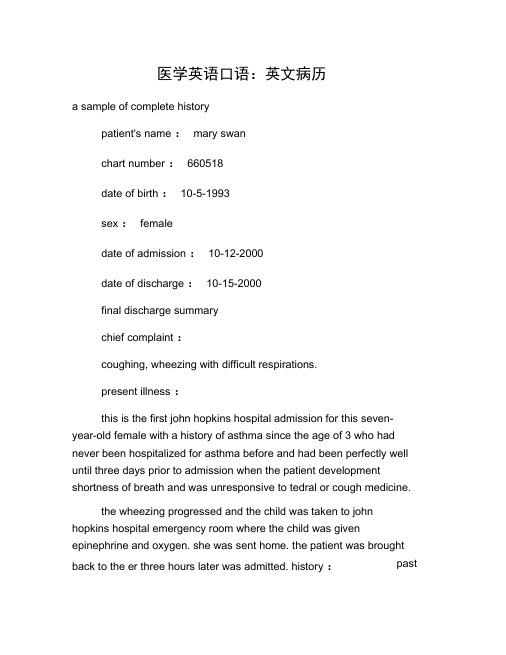
医学英语口语:英文病历a sample of complete historypatient's name :mary swanchart number :660518date of birth :10-5-1993sex :femaledate of admission :10-12-2000date of discharge :10-15-2000final discharge summarychief complaint :coughing, wheezing with difficult respirations.present illness :this is the first john hopkins hospital admission for this seven-year-old female with a history of asthma since the age of 3 who had never been hospitalized for asthma before and had been perfectly well until three days prior to admission when the patient development shortness of breath and was unresponsive to tedral or cough medicine.the wheezing progressed and the child was taken to john hopkins hospital emergency room where the child was given epinephrine and oxygen. she was sent home. the patient was brought back to the er three hours later was admitted. history :pastthe child was a product of an 8.5-month gestation. the mother had toxemia of pregnancy. immunizations :all. feeding good. allergies :chocolate, dog hair, tomatoes.family history :the mother is 37, alive and well. the father is 45, alive and well. two sibs, one brother and one sister, alive and well. the family was not positive for asthma, diabetes, etc.review of systems :negative except for occasional conjunctivitis and asthma.physical examination on admission :the physical examination revealed a well-developed and well-nourished female, age 7, with a pulse of 96, respiratory rate of 42 and temperature of 101.0 T . she was in a mist tent at the time of examination.funduscopic examination revealed normal fundi with flat discs. nose and throat were somewhat injected, particularly the posterior pharynx. the carotids were palpable and equal. ears were clear. thyroid not palpable. the examination of the chest revealed bilateral inspiratory and expiratory wheezes. breath sounds were decreased in the left anterior lung field. the heart was normal. abdomen was soft and symmetrical, no palpable liver, kidney, or spleen. the bowel sounds were normal. pelvic :normal female child. rectal deferred. extremities negative.impression :bronchial asthma, and pharyngitis.laboratory data :the white count on admission was 13,600 with hgb of 13.0. differential revealed 64 segs and 35 lymphs with 3 eos. adequate platelets. sputum culture and sensitivity revealed alpha hemolytic streptococcus sensitive to penicillin. chest x-ray on admission showed hyperaeration and prominent bronchovascular markings. the child was started on procaine penicillin 600,000 unites im q.d in accordance with the culture and sensitivity of the sputum.hospital course :the child was given penicillin im as stated above. ten drops of isuprel were added to the respirator every 2 hours. the patient improved steadily. she took her diet well. she was discharged on 10-15-2000 in good condition.operation procedure :nonecondition on discharge :improveddiagnosis :asthma. pharyngitis. possible right upper lobs pneumonia.new words and expressionswheeze vi & n. 喘息(声)asthma n. 哮喘、气喘病epinephrine n 肾上腺素gestation n 妊娠toxemia n 毒血症。
英语写病历作文模板
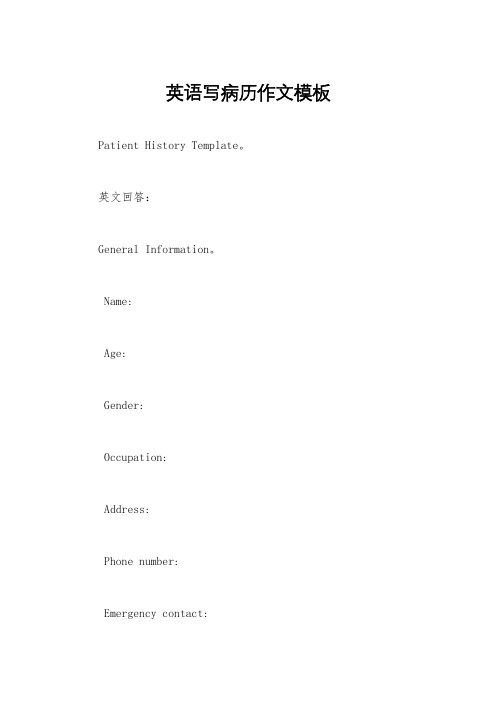
英语写病历作文模板 Patient History Template。
英文回答:General Information。
Name:Age:Gender:Occupation:Address:Phone number:Emergency contact:Medical History。
Past medical history: List any previous illnesses, surgeries, hospitalizations, or accidents.Family medical history: Note any history of chronic diseases, such as heart disease, cancer, or diabetes, in the patient's family.Allergies: List any known allergies to medications, foods, or other substances.Medications: List all current medications, including prescription drugs, over-the-counter medications, and herbal supplements.Social history: Discuss the patient's lifestyle, including diet, exercise, smoking, alcohol use, and drug use.Present Illness。
Chief complaint: State the patient's primary reasonfor seeking medical attention.History of present illness: Describe the onset, duration, severity, and progression of the patient's symptoms.Physical Examination。
英语病历小作文

英语病历小作文Title: A Patient's Medical Record。
Patient Information:Name: [Patient's Name]Age: [Patient's Age]Gender: [Patient's Gender]Date of Admission: [Date of Admission]Date of Birth: [Patient's Date of Birth]Medical Record Number: [Medical Record Number]Chief Complaint:The patient presented with [chief complaint]. Thesymptoms started [duration] ago and have been [description of symptoms].History of Present Illness:The patient reports [description of symptoms] associated with [chief complaint]. There is no history of [relevant negative symptoms]. The symptoms have [progressed/improved/remain unchanged] since onset.Past Medical History:The patient has a history of [relevant medical conditions], including [specific conditions]. Previous surgeries include [list of surgeries]. There is no history of [relevant negative medical history].Medications:The patient is currently taking [list of medications], including [medication names and dosages]. Allergies include [list of allergies], with reactions being [description ofreactions].Family History:There is a family history of [relevant medical conditions], including [specific conditions]. There is no family history of [relevant negative family history].Social History:The patient is [employment status] and lives in [living situation]. The patient [smokes/drinks/uses recreational drugs], with a history of [relevant social habits]. Thereis no history of [relevant negative social history].Review of Systems:Constitutional: [relevant findings]Eyes: [relevant findings]Ears, Nose, Throat: [relevant findings]Cardiovascular: [relevant findings]Respiratory: [relevant findings]Gastrointestinal: [relevant findings]Genitourinary: [relevant findings]Musculoskeletal: [relevant findings]Neurological: [relevant findings]Psychiatric: [relevant findings]Dermatological: [relevant findings]Endocrine: [relevant findings]Hematological/Lymphatic: [relevant findings] Allergic/Immunological: [relevant findings]Physical Examination:General: [relevant findings]Vital Signs: [vital signs values]Head: [relevant findings]Eyes: [relevant findings]Ears, Nose, Throat: [relevant findings] Cardiovascular: [relevant findings]Respiratory: [relevant findings]Gastrointestinal: [relevant findings] Genitourinary: [relevant findings]Musculoskeletal: [relevant findings]Neurological: [relevant findings]Psychiatric: [relevant findings]Dermatological: [relevant findings]Endocrine: [relevant findings]Hematological/Lymphatic: [relevant findings]Allergic/Immunological: [relevant findings]Laboratory and Diagnostic Results:[List of laboratory results and diagnostic findings] Assessment:[Primary diagnosis][Secondary diagnosis, if applicable]Plan:1. [Treatment plan for primary diagnosis]2. [Additional plans for secondary diagnosis or other issues]3. [Follow-up appointments and monitoring]Summary:In summary, the patient presents with [chief complaint] associated with [relevant medical history]. The physical examination revealed [relevant findings]. The assessment includes [primary and secondary diagnoses], and the plan consists of [treatment plan and follow-up]. Further investigations may be necessary to [address any remaining concerns or uncertainties].。
四年级英语病历范文
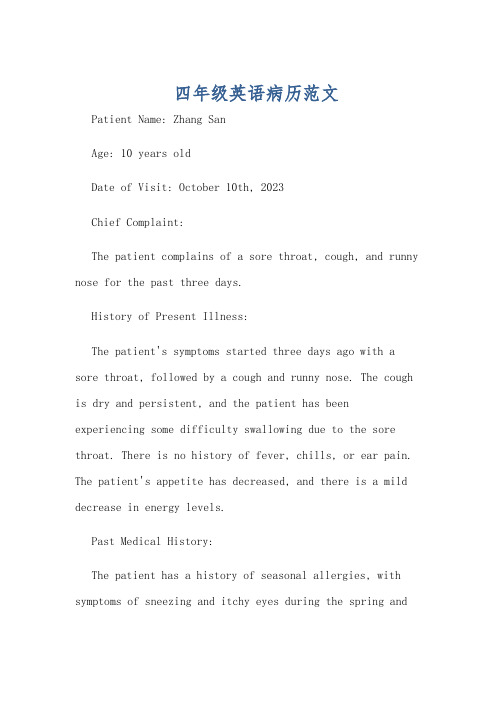
四年级英语病历范文Patient Name: Zhang SanAge: 10 years oldDate of Visit: October 10th, 2023Chief Complaint:The patient complains of a sore throat, cough, and runny nose for the past three days.History of Present Illness:The patient's symptoms started three days ago with a sore throat, followed by a cough and runny nose. The cough is dry and persistent, and the patient has been experiencing some difficulty swallowing due to the sore throat. There is no history of fever, chills, or ear pain. The patient's appetite has decreased, and there is a mild decrease in energy levels.Past Medical History:The patient has a history of seasonal allergies, with symptoms of sneezing and itchy eyes during the spring andfall seasons. There is no history of asthma or other chronic respiratory conditions.Family History:There is no significant family history of respiratory illnesses or other chronic conditions.Medications:The patient is not currently taking any medications.Allergies:The patient has no known drug allergies.Review of Systems:- Constitutional: Decreased appetite and energy levels - Respiratory: Sore throat, cough, runny nose- Gastrointestinal: No nausea, vomiting, or diarrhea - Musculoskeletal: No joint pain or swellingPhysical Examination:- Vital Signs: Temperature 98.6°F, pulse 80 beats per minute, respiratory rate 20 breaths per minute, blood pressure 110/70 mmHg- General: The patient appears fatigued, but alert and oriented- Head and Neck: Erythematous pharynx, no tonsillar exudates, clear nasal discharge- Respiratory: Lungs clear to auscultation bilaterally - Cardiovascular: Regular rate and rhythm, no murmurs or gallops- Abdomen: Soft, non-tender, non-distendedAssessment:Based on the patient's history and physical examination, the likely diagnosis is an upper respiratory tract infection, possibly viral in nature.Plan:1. Symptomatic treatment for sore throat and cough, including acetaminophen for pain and discomfort2. Encourage increased fluid intake and rest3. Monitor for any signs of worsening symptoms, such as persistent high fever or difficulty breathing4. Follow up in three days if symptoms do not improve or worsen中文回答:患者张三,10岁,主诉三天来咽喉痛、咳嗽和流鼻涕。
- 1、下载文档前请自行甄别文档内容的完整性,平台不提供额外的编辑、内容补充、找答案等附加服务。
- 2、"仅部分预览"的文档,不可在线预览部分如存在完整性等问题,可反馈申请退款(可完整预览的文档不适用该条件!)。
- 3、如文档侵犯您的权益,请联系客服反馈,我们会尽快为您处理(人工客服工作时间:9:00-18:30)。
1 病历case histroy一般事项date of admission /marital status /present address /correspondence / occupatio n主诉chief complaints现病史present illness / history of present illness既往史past medical history家族史family history个人病史personal history / social history曾用药物medications过敏史allergies系统回顾system review / review of system体检physical examination一般资料physical data 生理指标physical signs一般状况或全身状况general appearance头眼与耳鼻喉head ,eyes,ear,nose,throat ,略作heent.胸部与心肺CHEST,heart,and lungs腹部abodoms四肢extremities神经系统nervous system,Neurological,略作CNC或Neuro,骨骼肌系统Musculoskeletal泌尿生殖系统Genitourinary化验室资料laboratory data/ studies /diagnosis血液检查blood test化学7项指标chem.-7心脑电图electrocardiogram / electroencephalogram , 略作EKG/EEGX线检查与x光片X-ray examination, x-ray slides,计算机X线断层扫描与核磁共振扫描资料computerized x-ray tomography and nuclear mag netic resonance spectroscopy dta. CT AND NMR其他检查资料other lab data印象与诊断impression and diagnosis住院治疗情况hospital course出院医嘱discharge instructions / recommendations出院后用药discharge medications2 看病时用英文1) 一般病情:He feels headache, nausea and vomiting. (他覺得頭痛、噁心和想吐。
)He is under the weather. (他不舒服,生病了。
)He began to feel unusually tired. (他感到反常的疲倦。
)He feels light-headed. (他覺得頭暈。
)She has been shut-in for a few days. (她生病在家幾天了。
)Her head is pounding. (她頭痛。
)His symptoms include loss of appetite, weight loss, excessive fatigue, fever and chills. (他的症狀包括沒有食慾、體重減輕、非常疲倦、發燒和發冷。
)He feels exhausted or fatigued most of the time. (他大部份時間都覺得非常疲倦。
)He has been lacking in energy for some time. (他感到虛弱有段時間了。
) { 枫下论坛 .net /forum }He feels drowsy, dizzy and nauseated. (他覺得昏昏欲睡,頭暈目眩和想吐。
)He feels as though everything around him is spinning. (他感到周圍的東西都在打轉。
) He has noticed some loss of hearing. (他發覺聽力差些。
)She has some pains and itching around her eyes. (她眼睛四周又痛又癢。
)(2) 傷風感冒:He has been coughing up rusty or greenish-yellow phlegm. (他咳嗽帶有綠黃色的痰。
) His eyes feel itchy and he has been sneezing. (他眼睛發癢,而且一直在打噴嚏。
)He has a fever, aching muscles and hacking cough. (他有發燒,筋骨痠痛和常常咳嗽。
) (h acking = constant)He coughed with sputum and feeling of malaise. (他咳嗽有濃痰,而且覺得很虛弱。
) (mal aise = debility)He gets a cold with a deep hacking cough. (他傷風咳嗽。
)He has a headache, aching bones and joints. (他頭痛,骨頭、關節也痛。
)He has a persistent cough. (他不停地在咳。
) 或He has bouts of uncontrollable coughing. (他一陣陣的咳嗽,難以控制。
)He has hoarse and has lost his voice sometimes. (他聲音嘶啞,有時失聲。
)He has a sore throat and a stuffy nose. (他嗓子疼痛而且鼻子不通。
)His breathing is harsh and wheezy. (他呼吸時,有氣喘似的呼哧呼哧作響。
)He has a stabbing pain that comes on suddenly in one or both temples. (有時突然間太陽穴刺痛。
)He has a runny nose, sneezing or a scratchy throat. (他流鼻水,打噴嚏和喉嚨沙啞。
) (3) 女性疾病:She has noticed one lump in her breast. (她發覺乳房有個腫塊。
)There is a hard, swollen lump on her right breast. (她右乳房有腫塊。
)Her left breast is painful and swollen. (她左乳房疼痛且腫大。
)She has heavy bleeding with her periods. (她月經來的很多。
)Her vaginal discharge is white or greenish-yellow and unpleasant smelling. (她陰道分泌物帶白色或綠黃色,而且氣味不好。
)She has noticed occasional spotting of blood between periods. (在月經來的前後,她有時也發覺有滴滴達達的流血。
)She has some bleeding after intercourse. (性交後有出血。
)She feels some vaginal itching. (她感到陰部發癢。
)She has painful periods and abnormal vaginal discharge. (她月經來時疼痛,而且陰道有不正常的分泌物。
)(4) 手腳毛病:His both hands and feet ache all over. (他兩手兩腳都很痠痛。
)He has pain on the sole of his feet. (他腳底很痛。
)There is a wart-like lump on the sole of right foot. (我右腳底有個像肉疣般的硬塊。
) His ankles look puffy and they pit when he presses them with his finger. (他的足踝好像腫了,用手按,就有小坑痕。
) (pit = small dent form)(句裡的they 和them 都是指ankles)The pain in his left foot is accompanied by redness and swelling. (左腳痠痛,並有紅腫。
)The joints near his fingernails and knuckles look swollen. (指頭和指節旁邊的關節,似乎有腫大。
)He has numbness and tingling in his hands and fingers. (他的手和指頭感到麻木和刺痛。
) His legs become painful following strenuous exercise. (激烈運動後,他的腿就痛。
)His knee is misshapen or unable to move. (他的膝蓋有點畸形,也不能動。
)There are some swellings in his armpit. (他的腋窩腫大。
)He is troubled with painful muscles and joints. (他的筋骨和關節都痛。
)She is troubled by the pains in the back and shoulders. (她的後背和肩膀都痛。
)His knee has been bothering him for some time. (他的膝蓋不舒服,已有一段時間了。
) (5) 睡眠不好:He is sleeping poorly.(他睡不好)He has difficulty in sleeping, inability to concentrate.(他不易入睡,也難集中精神。
)It is usually hard for her to fall asleep when she goes to bed at night.(她晚上就寢,很難入睡。
)He wakes during the night or early morning and finds it difficult to fall asleep again.(他晚間或清早醒來後,再也不能入睡。
)He has nightmares occasionally.(他有時做噩夢。
